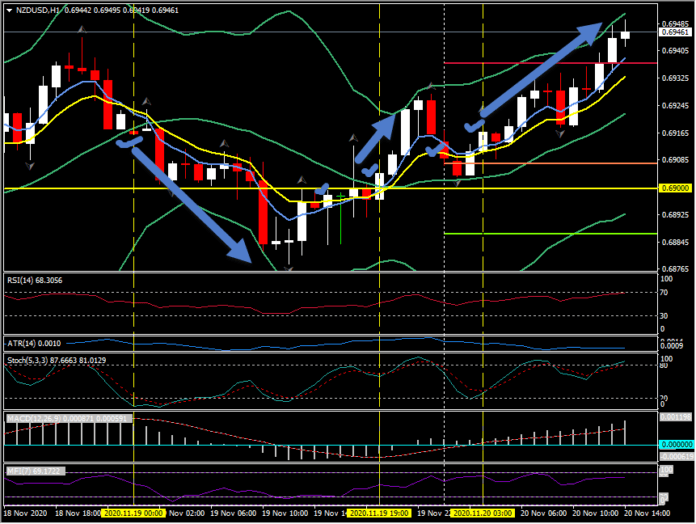NZD/USD, H1
Currencies have largely remained within recent ranges. Risk appetite picked up during the European morning, which saw the Dollar bloc currencies lift. Asian stock markets lifted after starting out weak, with the main indices across the region finishing in a mix of modest losses and modest gains. Europe’s Stoxx 600 was up 0.6%, and S&P 500 E-mini futures had pared intraday declines and were near flat heading into the New York interbank open. Base metal prices remain perky, with copper lifting to two-and-a-half-year highs while aluminium prices posted a new two-year high. Bitcoin surged to a fresh three-year high.
In Europe, an EU official said that an agreement with the UK was near on most issues, which helped maintain an underpinning for the Pound, though neither side has been willing as yet to begin the concession phase on key sticking points. In Asia, the PBoC kept the Loan Prime Rate unchanged for a seventh straight month while draining a net CNY80 bln via monetary policy tools, suggesting that the bank is tapering its emergency support programs. Japan core inflation fell to -0.7% y/y, which will cause an unwanted tightening in real interest rates in Japan.
Among currencies, the USDIndex matched Wednesday’s 11-day low at 92.21 while EURUSD lifted to a two-day high at 1.1891. USDJPY plied a sub-20 pip range in the upper 103.00s, holding above the 11-day low that was seen earlier in the week at 103.64. Sterling traded modestly firmer against the dollar, euro and yen, among other currencies, though mostly held within recent ranges. Cable edged out a two-day high at 1.3291. The pair’s two-and-a-half month high, clocked on Wednesday, is at 1.3314. The largest mover of the main pairs at 13:00 GMT is the NZDUSD up +0.88% and testing the 0.6950 zone.
Later we have the US Retail Sales data and expectations are for a 0.6% October retail sales gain with a 0.7% ex-autos increase, after respective September gains of 1.9% and 1.5%. Chain store sales improved in October, but remained depressed. Consumer confidence remained firm despite pullbacks in some measures. Construction employment continued to improve, bolstering the outlook for building material sales. However, vehicle sales slowed and the gasoline component of CPI fell -0.5% in October.
Disclaimer: Nothing in this communication contains, or should be considered as containing, an investment advice or an investment recommendation or a solicitation for the purpose of purchase or sale of any financial instrument.
Recommended Content
Editors’ Picks
AUD/USD could extend the recovery to 0.6500 and above

The enhanced risk appetite and the weakening of the Greenback enabled AUD/USD to build on the promising start to the week and trade closer to the key barrier at 0.6500 the figure ahead of key inflation figures in Australia.
EUR/USD now refocuses on the 200-day SMA

EUR/USD extended its positive momentum and rose above the 1.0700 yardstick, driven by the intense PMI-led retracement in the US Dollar as well as a prevailing risk-friendly environment in the FX universe.
Gold struggles around $2,325 despite broad US Dollar’s weakness

Gold reversed its direction and rose to the $2,320 area, erasing a large portion of its daily losses in the process. The benchmark 10-year US Treasury bond yield stays in the red below 4.6% following the weak US PMI data and supports XAU/USD.
Bitcoin price makes run for previous cycle highs as Morgan Stanley pushes BTC ETF exposure

Bitcoin (BTC) price strength continues to grow, three days after the fourth halving. Optimism continues to abound in the market as Bitcoiners envision a reclamation of previous cycle highs.
US versus the Eurozone: Inflation divergence causes monetary desynchronization

Historically there is a very close correlation between changes in US Treasury yields and German Bund yields. This is relevant at the current juncture, considering that the recent hawkish twist in the tone of the Federal Reserve might continue to push US long-term interest rates higher and put upward pressure on bond yields in the Eurozone.


